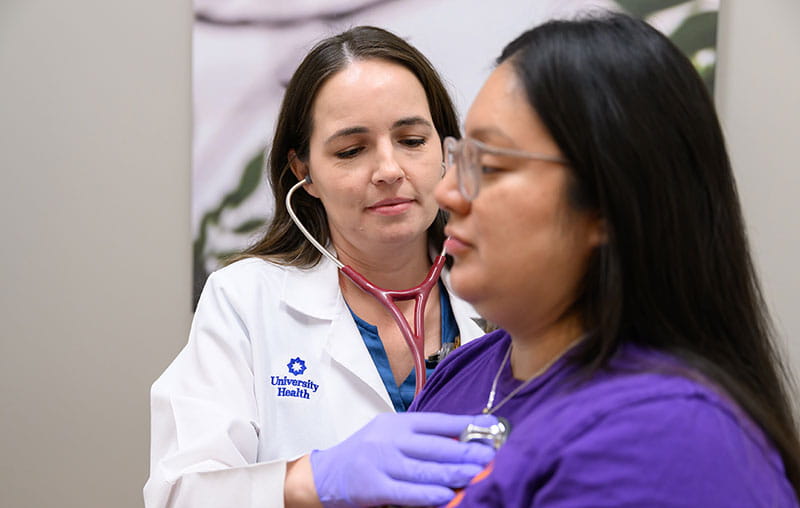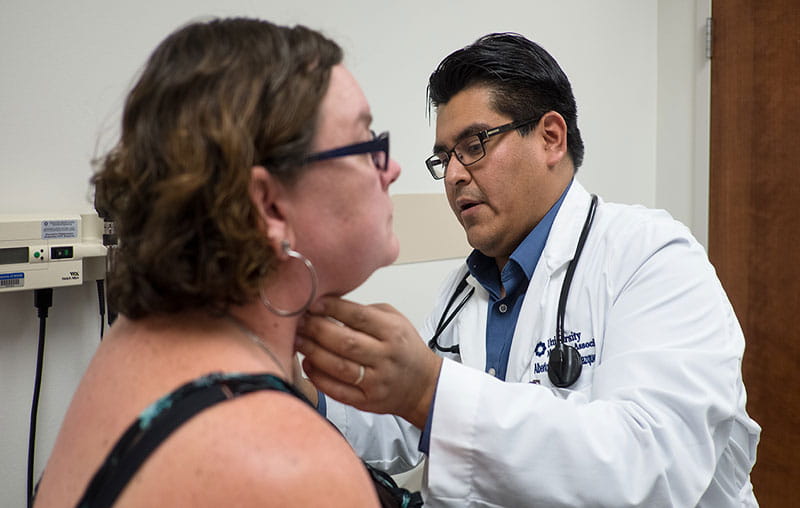Lung cancer is the deadliest cancer in the United States. Every year, it kills more people than prostate, breast and colon cancer combined, according to the American Cancer Society.
More than 130,000 people will die of lung cancer in the U.S. in 2022.
Causes of Lung Cancer
Smoking cigarettes puts people at greater risk, causing 80% of lung cancer deaths, according to the Centers for Disease Control and Prevention.
Those who smoke cigarettes are 25 times more likely to develop lung cancer than people who have never smoked. Learn about smoking cessation at University Health.
Signs and Symptoms of Lung Cancer
In many cases, in the early stages of lung cancer, there are no symptoms. This can make it difficult to know if you have cancer. If you have symptoms, they might be:
- Persistent cough
- Chest pain
- Wheezing
- Shortness of breath
- Coughing up blood
- Getting bronchitis or pneumonia frequently
If the cancer has spread outside the lung, you may experience different symptoms, including:
- Blood clots
- Weight loss
- Headaches
- Loss of appetite
If you’re eligible and believe you are at risk, you should get a low-dose CT (computed tomography) scan to check for lung cancer.
How Lung Cancer Is Diagnosed
To determine if you have lung cancer, your provider may order an imaging scan or a tissue biopsy. Imaging scans are noninvasive and include:
- CT scan: In this scan, you will lay flat on a table that moves in and out of the scanning machine. The machine will take multiple X-ray images of your body and put them together for a more complete picture.
- PET scan: In this scan, your provider will inject a radioactive sugar isotope into your blood. This helps show cancer cells in your body. This scan is more detailed than a CT scan.
Lung Cancer Treatment Options
Depending on what stage the cancer is, your overall health, age, personal preferences and goals, you may have multiple treatment options. Your doctor will explain each option to you, including risks and benefits. Your options may include:
- Surgery
- Radiation therapy
- Chemotherapy
- Targeted therapy
- Immunotherapy
- Clinical trials
If your cancer is in a later stage, your doctor may also discuss palliative care, supportive care, hospice care and alternative therapies.
Lung Cancer 5-Year Survival Rate
Only 17% of lung cancer cases are caught early enough, when the cancer is still localized (contained in the lung), to provide adequate treatment.
Unfortunately, most lung cancers are detected when individuals are already symptomatic, leading to late-stage diagnosis and a low five-year survival rate.
When lung cancer is caught in the local stage, those patients have a 61% 5-year survival rate. Compare this to a 6% survival rate when lung cancer is diagnosed at a distant stage.
For all stages of lung cancer, the average survival rate is 21%.
Get a Lung Cancer Screening
The American Cancer Society recommends lung cancer screenings using a low-dose CT imaging scan. Low-dose CT scans can reduce lung cancer deaths by 20-33%. As with mammograms, there is the possibility of false positives.
Low-dose CT scans for lung cancer screening are covered by most insurance plans, including Medicare and Medicaid.
By identifying eligible patients and helping them access these scans, more lung cancer cases can be diagnosed at earlier stages. Ask your primary care provider for more information.




